#mosasaurus hoffmannii
Text

a Mosasaurus hoffmannii navigates a shallow reef as a pair of Ornithocheirus simus pass overhead.
a fun little speedpaint using my phone and sketchbook app. I want to make a lot of actual paleoart next year for sure!
#speedpaint#digital art#paleoart#mosasaur#mosasaurus hoffmannii#ornithocheirus#ornithocheirus simus#marine reptile#pterosaur
263 notes
·
View notes
Text

Made a funky lil guy, this is prob the longest I have ever spent on a drawing and I'm pretty proud of it :]
He is a mosasaurus hoffmannii :]
1 note
·
View note
Text
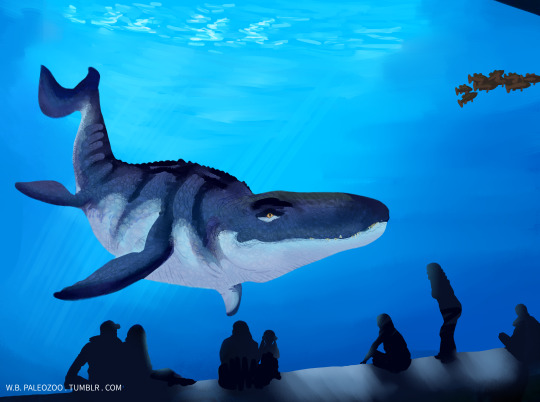
Image captured by our staff of our large predator Mosasaurus hoffmannii (named Shaun by popular vote) in our underground viewing level, located at the "Mosasaur Bay" exhibit!
"Mosasaurs are a group of marine lizards that would have lived in the Badlands area from about 75-69 million years ago. When they were alive, Mosasaurs could reach lengths of up to 50 feet, which is roughly the length of a bus! Mosasaurs were top predators of the world’s oceans and would eat anything they could catch." ( X )
1 note
·
View note
Text


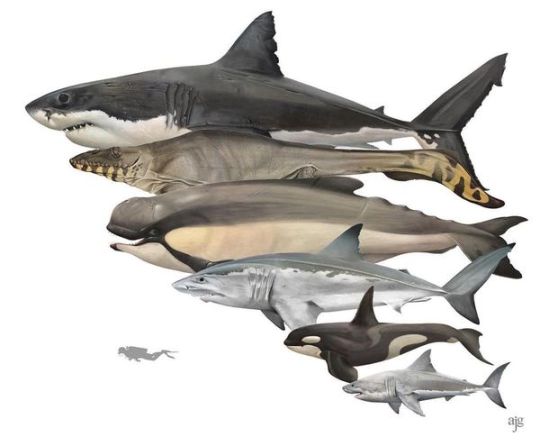
Extant and Prehistoric Sea Creatures
(From top to bottom:)
Otodus megalodon, Mosasaurus hoffmannii, Livyatan melvillei, Otodus obliquus, Killer Whale - Orcinus orca, Great White Shark - Carcharodon carcharias
Artist: ajgusillustration
33 notes
·
View notes
Text

Mosasaurus hoffmannii
16 notes
·
View notes
Text

Under the sea during the Late Cretaceous Period, around 66 million years ago, Mosasaurus hoffmannii pursues an ammonite for lunch. Stretching between thirty and sixty feet in length, this massive predatory sea lizard would have most likely been the apex predator of the Late Cretaceous oceans. Its closest living relatives would be snakes and monitor lizards such as the Komodo dragon.
If you’re wondering what those pink things with the tentacles in the lower right corner are, they are rudists, an order of molluscs that would have dominated reefs during the Cretaceous Period. They died out approximately at the same time as the mosasaurs and the non-avian dinosaurs at the end of the Mesozoic Era.
14 notes
·
View notes
Text

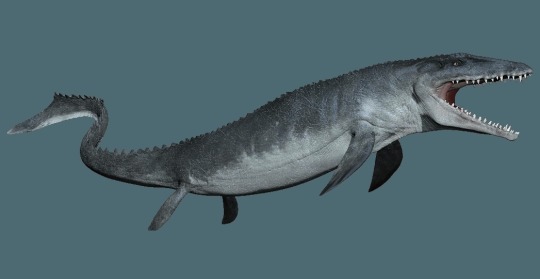

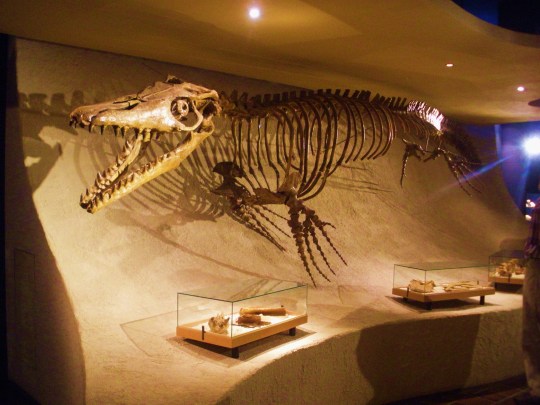
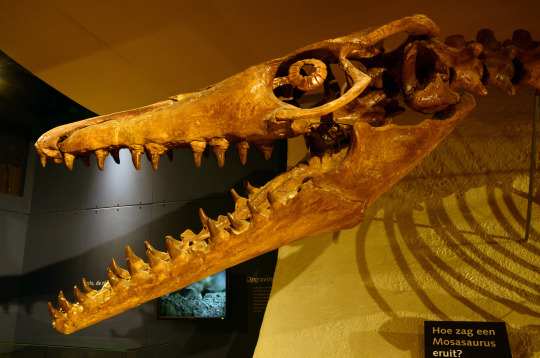


Mosasaurus
(temporal range: 82.7-66.0 mio. years ago)
[text from the Wikipedia article, see also link above]
Mosasaurus (/ˌmoʊzəˈsɔːrəs/; "lizard of the Meuse River") is the type genus (defining example) of the mosasaurs, an extinct group of aquatic squamate reptiles. It lived from about 82 to 66 million years ago during the Campanian and Maastrichtian stages of the Late Cretaceous. The genus was one of the first Mesozoic marine reptiles known to science—the first fossils of Mosasaurus were found as skulls in a chalk quarry near the Dutch city of Maastricht in the late 18th century, and were initially thought to be the bones of crocodiles or whales. One skull discovered around 1780, which was seized by France during the French Revolutionary Wars for its scientific value, was famously nicknamed the "great animal of Maastricht". In 1808, naturalist Georges Cuvier concluded that it belonged to a giant marine lizard with similarities to monitor lizards but otherwise unlike any known living animal. This concept was revolutionary at the time and helped support the then-developing ideas of extinction. Cuvier did not designate a scientific name for the new animal, and this was done by William Daniel Conybeare in 1822 when he named it Mosasaurus in reference to its origin in fossil deposits near the Meuse River. The exact affinities of Mosasaurus as a squamate remain controversial, and scientists continue to debate whether its closest living relatives are monitor lizards or snakes.
Traditional interpretations have estimated the maximum length of the largest species, M. hoffmannii, to be up to 17.1 meters (56 ft), making it one of the largest mosasaurs, although some scientists consider this an overestimation with recent estimates suggesting a length closer to 13 meters (43 ft). The skull of Mosasaurus was equipped with robust jaws capable of swinging back and forth and strong muscles capable of powerful bites using dozens of large teeth adapted for cutting prey. Its four limbs were shaped into robust paddles to steer the animal underwater. Its tail was long and ended in a downward bend and a paddle-like fluke. Mosasaurus was a predator possessing excellent vision to compensate for its poor sense of smell, and a high metabolic rate suggesting it was endothermic ("warm-blooded"), an adaptation in squamates only found in mosasaurs. There is considerable morphological variability across the currently-recognized species in Mosasaurus—from the robustly-built M. hoffmannii to the slender and serpentine M. lemonnieri—but an unclear diagnosis (description of distinguishing features) of the type species M. hoffmannii led to a historically problematic classification. As a result, more than fifty different species have been attributed to the genus in the past. A redescription of the type specimen in 2017 helped resolve the taxonomy issue and confirmed at least five species to be within the genus. Another five species still nominally classified within Mosasaurus are planned to be reassessed in a future study.
Fossil evidence suggests Mosasaurus inhabited much of the Atlantic Ocean and the seaways adjacent to it. Mosasaurus fossils have been found in places as diverse as North and South America, Europe, Africa, Western Asia, and Antarctica. This distribution encompassed a wide range of oceanic climates including tropical, subtropical, temperate, and subpolar climates. Mosasaurus was a common large predator in these oceans and was positioned at the top of the food chain. Paleontologists believe its diet would have included virtually any animal; it likely preyed on bony fish, sharks, cephalopods, birds, and other marine reptiles including sea turtles and other mosasaurs. It likely preferred to hunt in open water near the surface. From an ecological standpoint, Mosasaurus probably had a profound impact on the structuring of marine ecosystems; its arrival in some locations such as the Western Interior Seaway in North America coincides with a complete turnover of faunal assemblages and diversity. Mosasaurus faced competition with other large predatory mosasaurs such as Prognathodon and Tylosaurus—which were known to feed on similar prey—though they were able to coexist in the same ecosystems through niche partitioning. There were still conflicts among them, as an instance of Tylosaurus attacking a Mosasaurus has been documented. Several fossils document deliberate attacks on Mosasaurus individuals by members of the same species. In fighting likely took place in the form of snout grappling, similarly seen in modern crocodiles today.
6 notes
·
View notes
Photo

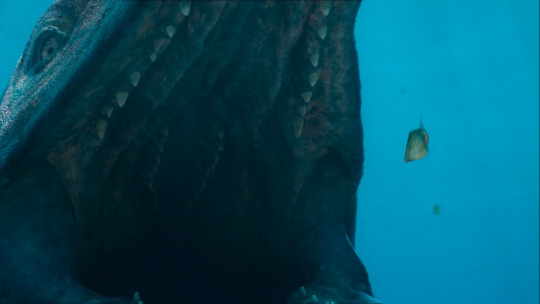



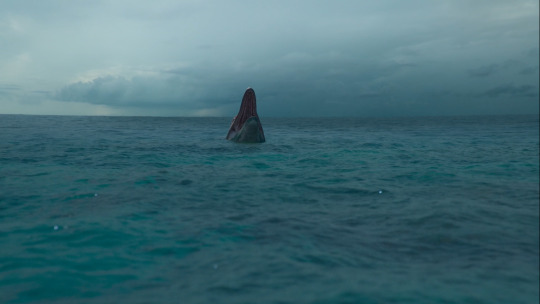


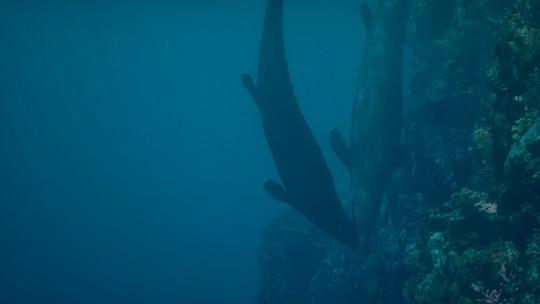

Life of our Prehistoric Planet: Mosasaurus hoffmannii.
#prehistoric planet#prehistoric planet season 1#mosasaurus#mosasaur#marine reptile#cretaceous period#mine#q
12 notes
·
View notes
Text
Mosasaurus hoffmannii
Dibujo de uno de mis reptiles acuáticos del mesozoico favoritos, Un increíble gigante marino de los mares del cretácico. 💙Era mesozoica. Periodo: cretácico. Género: Mosasaurus. Especie: Mosasaurus hoffmannii.
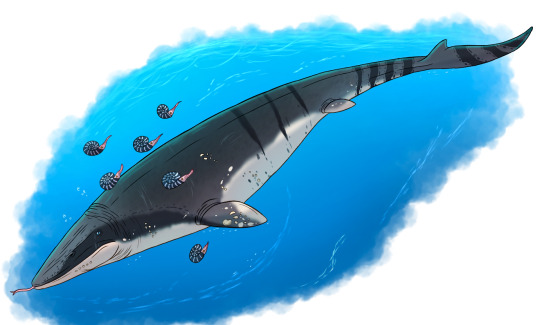
#reptile#mosasaurus#paleoart#digital art#animals#art#prehistoric animals#digital illustration#marine animals#mesozoica#cretaceous period
17 notes
·
View notes
Text
i just wanted to announce my favourite tyrannosaurus is the Mosasaurus more precisely the hoffmannii
1 note
·
View note
Text
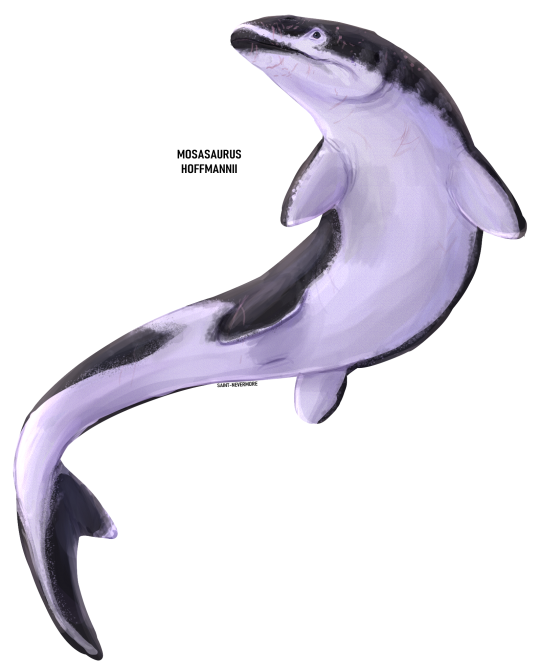
Mosasaurus hoffmannii
trying a different type of this font as it looks better...Mosasaurus was not a dinosaur, but instead closely related to monitor lizards! :)
#paleoart#not a dinosaur#paleontology#art#reptiles#squamata#mosasaur#mosasaurus#mosasaurus hoffmannii#aquatic reptile#also aware the scale texture i used isnt correct 100% but i amnsleepi#overlapping scales are also so hard to do as atexture and take forwver by hand!#august 17th 2021
782 notes
·
View notes
Photo

Cretaceous Leviathan and Krakens by tuomaskoivurinne
#Mosasaurus#Mosasaurus hoffmannii#Marine reptile#Parapuzosia#Parapuzosia seppenradensis#Ammonite#Prehistoric#Mesozoic#Cretaceous#Extinct#Art
174 notes
·
View notes
Photo


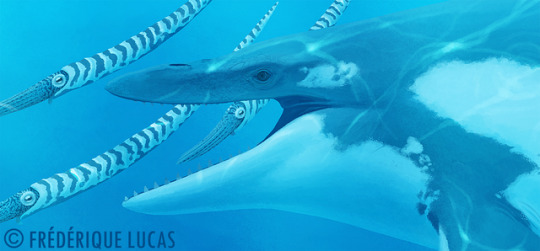
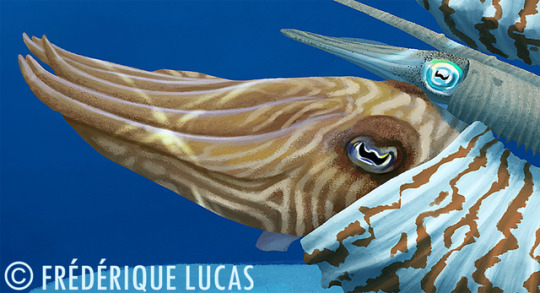

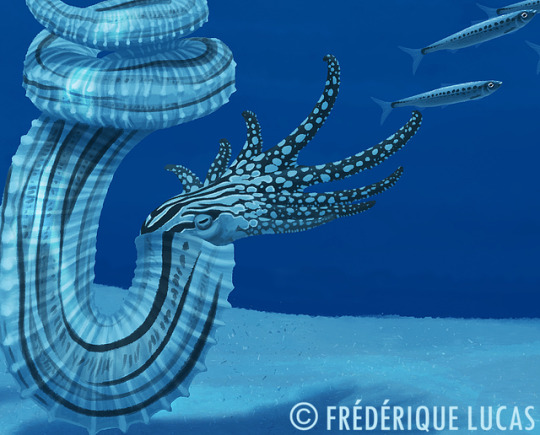
“Barry’s Ammonites”
This painting was commissioned by a friend, who wanted to give this as a Christmas present to her husband. He used to dig up ammonite fossils in the United States. This piece recreates some of the species he found most often, in the way they may have been all those millions of years ago.
Species portrayed are: a male and female Didymoceras stevensoni, D. nebrascence, D. cheyennense going after some fish, two Oxybeloceras sp. having a showdown, a shoal of Solenoceras sp., ‘Slash’ the ammonite, Mosasaurus hoffmannii, three Baculites grandis about to become Christmas dinner, Archelon ischyros way in the background, and some unspecified Crinoids. Now this is probably the right time to say that I am not a professional paleo artist. Ammonites are obviously not my area of expertise, and all the markings and soft parts are completely speculative, largely based on modern cephalopods. Still, I am very happy with the end result, and I learned so much while painting. About how to make sand look like sand, how many colours cuttlefish have in their eyes, how water caustics work. Details added to show off some of those little sparkles and dots and things!
Just for the record, this painting ended me. It took more than 45 hours work to do, one ~13-hour portion of which was done almost non-stop until 4 in the morning. I had a deadline. And I vastly underestimated this thing.
#paintings#Didymoceras stevensoni#Didymoceras#Didymoceras nebrascence#Didymoceras cheyennense#Oxybeloceras#Solenoceras#slash#slash the ammonite#Mosasaurus hoffmannii#Mosasaurus#Mosasaur#Baculites grandis#Baculites#Archelon ischyros#Archelon#Ammonite#ammonites#crinoids#digital art#artists on tumblr#paleoart
75 notes
·
View notes
Photo

Mosasaurus hoffmannii is one of the largest mosasaurs with lenghts of 11 up to maybe 18m.Is he lunging at prey or just happy to be here?
A fairly quick drawing to join in on Mosasaur Week, they are some of my favorite extinct animals after all!
#paleoart#my art#extinct#animal#mosasaurus#hoffmannii#prehistoric#cretaceous#marine reptile#ocean#aquatic#sciart#mosasaurweek#squamata#reptile#digital art
42 notes
·
View notes
Photo
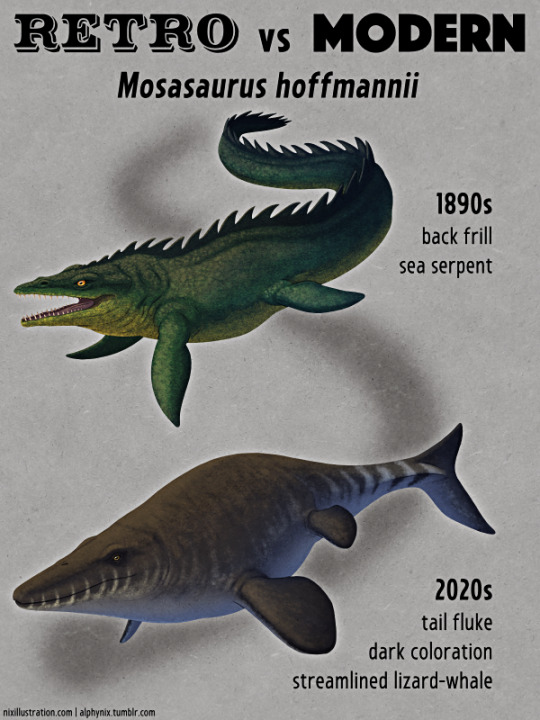
Retro vs Modern #07: Mosasaurus hoffmannii
The first scientifically documented mosasaur fossils were skulls discovered in the Netherlands during the 1760s and 1770s, but these remains were initially interpreted as belonging to a fish, crocodile, or whale. In the late 1790s their resemblance to monitor lizards was noted, and the fossils were soon recognized as belonging to giant marine reptiles unlike any known living species – a revolutionary concept at the time, and influential in the early development of ideas about extinction.
In the 1820s Mosasaurus hoffmannii was the first species officially described. For several decades it was thought to be a giant amphibious lizard with either webbed feet or flipper-like legs, with one of the earliest popular reconstructions being the 1850s Crystal Palace statue.
By the 1870s more complete fossil discoveries in North America had revealed the paddle-like flippers and fully aquatic nature of mosasaurs. Skin impressions showed overlapping keeled diamond-shaped scales resembling those of rattlesnakes, but proportionally much smaller compared to their body size.
1890s
Then, in the late 1890s, one mosasaur specimen was interpreted as having a mane-like "fringe" of soft tissue along its back.
Only a few years later this was realized to be a mistake, actually being preserved tracheal cartilage, but it was too late. The idea had already caught on in artistic depictions and quickly became a paleoart meme, with mosasaurs frequently portrayed with elaborate frills for the majority of the next century.
2020s
Early arguments about whether mosasaurs’ closest relatives were monitor lizards or snakes had settled down by the 1920s, with the consensus at the time being monitor lizards, and the first half of the 20th century saw little mosasaur research beyond the naming of a few new species. Much like the ichthyosaurs and plesiosaurs it was only really in the wake of the Dinosaur Renaissance that interest in these marine reptiles and their paleobiology really began to pick up again.
Rather than sea-serpent-like creatures we now recognize that mosasaurs actually looked more like lizards converging on whales or ichthyosaurs, with smooth streamlined bodies and vertical tail flukes. The size and shape of their scales varied across different parts of their bodies, parts of their bodies had dark coloration (likely with a countershaded pattern), and they probably had forked tongues.
They had a higher metabolic rate than most modern lizards, and may even have been warm-blooded. They probably also gave birth to live young, although a recently-discovered fossil soft-shelled egg found in Antarctica has been suggested to have come from a large mosasaur.
The debate about their evolutionary relationships has been reignited, too, with some recent studies once again supporting a very close relationship to snakes – although there's currently no clear consensus.
Our modern view of Mosasaurus hoffmannii is a large chunky mosasaur that grew to at least 11m long (~36'). It lived during the end of the Cretaceous period, about 70-66 million years ago, and inhabited a wide range of climates across much of the ancient Atlantic Ocean and various connected shallow seaways, with fossils known from Europe, Africa, and North and South America.
Its long jaws had a powerful bite force and it seems to have been a more visual hunter than some other mosasaurs, with relatively large eyes and a less well-developed sense of smell. It was one of the largest marine animals of its time and was probably a generalist apex predator, feeding on a wide variety of prey such as fish, ammonites, and other marine reptiles.
———
Nix Illustration | Tumblr | Twitter | Patreon
#retro vs modern 2022#science illustration#paleontology#paleoart#palaeoblr#mosasaurus#mosasauridae#mosasauroidea#mosasaur#squamata#lepidosauria#reptile#marine reptile#art#retrosaurs
1K notes
·
View notes
Text


Mosasaurus hoffmannii tooth
22 notes
·
View notes